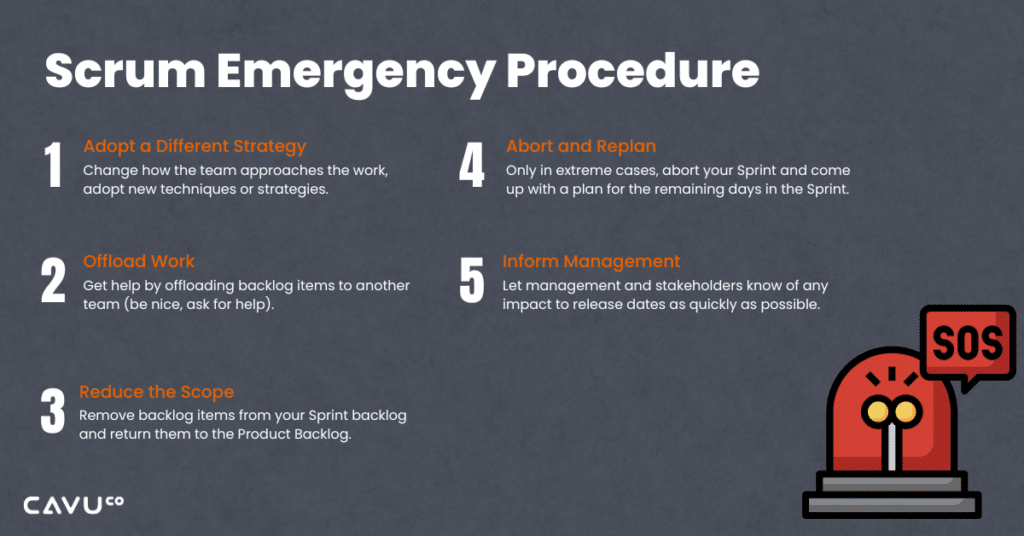In Scrum, the concept of a Sprint is foundational, providing a structured timeline for teams to deliver work consistently. However, there are times when teams face the dilemma of whether to extend a Sprint. So, can a Sprint be extended in Scrum? Broadly, there are two scenarios: needing more time for a single Sprint’s workload and contemplating a permanent change in Sprint duration due to consistent work overflows.
In Scrum, it’s ideal to maintain a consistent Sprint cadence. For a failing Sprint, utilize the Scrum Emergency Procedure for quick replanning. If a permanent adjustment to the Sprint length is necessary, ensure it’s an infrequent (almost never) decision and keep the Sprint duration to no longer than one month for optimal results.
Is it okay to extend or change the end date of a Sprint in Scrum?
The core question here is whether it’s ever acceptable to extend a Sprint. While the Scrum Guide doesn’t explicitly mention never altering Sprint lengths, it emphasizes that a Sprint is a fixed-length event (meaning, you don’t alter the Sprint length). There are situations in which a team might make a long-term change to their cadence (lengthening or shortening it), but the cadence should not change frequently or to accommodate the work in a given Sprint. It’s crucial to understand that the consistency of Sprint length is vital for maintaining the rhythm and predictability essential in Scrum processes.
Why would a Scrum Team want to extend a Sprint?

Inability to Complete Work:
If a team can’t finish the committed work in a Sprint, they might consider extending it. However, the recommended approach is to use the Scrum Emergency Procedure, which involves reassessing and adjusting the Sprint Backlog without extending the Sprint duration.
Work Requires More Time:
Sometimes, the nature of the work might require more time for completion. Before opting to extend the Sprint length, teams should examine their refinement processes to see if work can be broken down into smaller increments. If this isn’t feasible, then a long-term adjustment to the Sprint length can be considered.
Aligning with Other Teams:
To synchronize with other teams’ cadences, a team may consider adjusting their Sprint length. This is a valid reason, as long as the change is intended to be long-term and aligns with the overall workflow and organizational objectives.
Holidays or Planned Time Off:
Teams should avoid altering their Sprint schedule due to holidays or planned time off. Instead, they can adjust the workload or commitments for that Sprint. If a holiday interferes with Scrum events like planning or reviews, these events can be shifted accordingly, ensuring there’s no significant gap between planning and the start of work. Ideally, Sprints should start mid-week rather than on a Monday or Friday to minimize the impact of holidays or weekends.
Why do Sprints fail?
Most teams that are considering extending a Sprint are doing so because they are about to fail to deliver on their Sprint commitment. Sprints in Scrum can fail for various reasons, and understanding these can be key to improving future iterations. Here are some common causes:
- Poor Refinement and Understanding of Definition of Done or Definition of Ready: If the team has a vague or incomplete understanding of the Definition of Done or if backlog items are not well-refined and do not meet your Definition of Ready, it can lead to unrealistic expectations and unmet goals.
- Inaccurate Capacity Planning: Failing to effectively account for the team’s actual capacity can result in overcommitment and subsequent failure to deliver.
- Lack of Interrupt Buffer: Not maintaining an interrupt buffer for unexpected issues or interruptions can derail the planned work of a Sprint.
- Unanticipated Complexity: Sometimes, work is more challenging than expected, which can lead to delays and incomplete tasks.
It’s important to remember that failing a Sprint is not a cause for reprimand. Instead, it should be viewed as a learning opportunity. Failures are a ‘First Attempt In Learning.’ The key is to fail fast, fail often, and fail forward. Use the Retrospective to inspect and adapt.
What happens next if you fail a Sprint?

In the event of a failing Sprint, the Scrum Emergency Procedure can be a valuable tool. Here’s what you can do:
- Adopt a Different Strategy: Change how the team approaches the work, potentially adopting new techniques or strategies.
- Seek Assistance or Offload Work: Get help from outside the team. Ask other teams for help by taking a backlog item off your plate.
- Reduce the Scope: Re-evaluate and possibly reduce the scope of the project to meet the current capacity and resources.
- Abort the Sprint and Replan: In extreme cases, you might abort the Sprint and start with a new plan. In this case, you don’t reset your Sprint cadence. Just replan with the days you have remaining in your current Sprint.
- Inform Management: If the Sprint failure impacts release dates or major deliverables, it’s crucial to communicate this to management promptly.
Remember, the aim is not to extend the Sprint but to adapt within its constraints. Maintaining the Sprint cadence and using setbacks as opportunities for improvement are fundamental to the Scrum philosophy.








